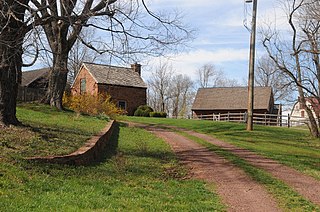
Darnall Place is a historic farm complex located at Poolesville, Montgomery County, Maryland, United States. The farm complex consists of four small 18th-century stone buildings, a 19th-century frame wagon shed/corn crib, a 20th-century concrete block barn, and three late-19th- or early-20th-century frame sheds. The stone buildings are all constructed of red-brown Seneca sandstone. The one-story dwelling has a large external stone chimney on the east end. The farmstead is reminiscent of those in Europe or the British Isles.
McPherson's Purchase is a historic farm complex dating to the 19th century and located near Pomfret, Charles County, Maryland, United States.
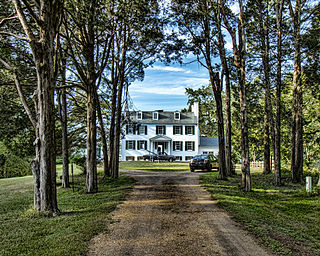
Mount Aventine is a farm complex and national historic district located along the Potomac River in Bryans Road, Charles County, Maryland. The complex includes the main house; a second-quarter 19th century Greek Revival-influenced brick house. It was enlarged about 1860 to its present five-bay, center-passage, 2+1⁄2-story appearance. Also on the property are a 19th-century frame smokehouse, the site of another 19th-century house complex, late-19th /early-20th-century agricultural outbuildings, house and dairy barn complex built about 1900, historic roadbeds, a family cemetery, and sites of a 19th-century fishery and an 18th-century house.
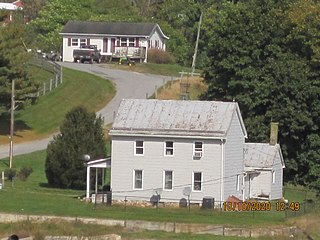
The Drummine Farm is a historic home and farm complex located at New Market, Frederick County, Maryland, United States. The main house was constructed about 1790 and is a 2+1⁄2-story structure of uncoursed fieldstone. The house retains Georgian stylistic influences in exterior and interior decorative detailing. The farm complex structures include a stone tenant house dated 1816, and four additional fieldstone buildings from the early 19th century: a smokehouse, a water storage house, a garden outhouse, and a large bank barn. Wooden farm buildings include a calf shed and a wagon shed with corn cribs from the late 19th century, a dairy barn with three cement stave silos from the 1930s, several sheds and garages, and a large pole barn.

Rich Mountain is a historic home and farm complex located at Frederick, Frederick County, Maryland, United States. It is on the remaining 10-acre (40,000 m2) tract from the original farm. The complex consists of a stone dwelling dating from 1810 to 1820 with a one-story kitchen wing; a 19th-century frame Pennsylvania barn; and a hog barn, wagon shed / corn crib, equipment shed, and chicken coop. The house combines Federal style elements with regional vernacular features.
The Daniel Sheffer Farm is a historic home and farm complex located at Middletown, Frederick County, Maryland, United States. It is dominated by the two story brick main house, which was constructed between 1840 and 1850. Outbuildings include a stone spring house, a large wood-frame barn, constructed about 1900, and several wood-frame outbuildings including a corncrib, a wagon shed, three frame wood sheds, two tractor sheds, and a chicken house. A concrete block milk house and terra cotta silo were added to the complex in the 1930s. In September 1862, the property served as a temporary hospital for wounded soldiers during the Battle of South Mountain in the American Civil War.

The George Markell Farmstead, also known as Arcadian Dairy Farm and the Thomas Property, is a historic home and farm complex located at Frederick, Frederick County, Maryland, United States. It consists of brick house built about 1865, a brick smokehouse, a bake oven, two stone domestic outbuildings, an ice house, a springhouse, a frame stable, a frame chicken house, a mid-20th century guest house, and various sheds and outbuildings. Nearby is a large gambrel-roofed concrete block barn. The main house has combined Greek Revival and Italianate stylistic influences. The once large Markell dairy farm, with its lane to the Ballenger Creek ford of the Monocacy River, served as the primary approach route to the battlefield by Confederate troops during the July 9, 1864 Battle of Monocacy during the American Civil War.
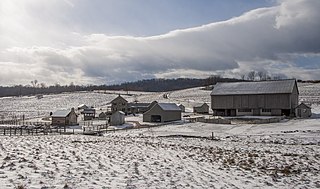
Peter of P. Grossnickel Farm is a historic home and farm complex located at Myersville, Maryland, Frederick County. It consists of a mid-19th-century, Greek Revival farmhouse and 13 related buildings and structures. The house is a 2+1⁄2-story stone center-passage house on a limestone foundation, with a 1+1⁄2-story kitchen wing and 18-inch-thick (460 mm) walls. The house was built between 1840 and 1850. Also on the property is an 1881 tenant house with corresponding barn, spring house, and washhouse / privy; an 1884–1897 bank barn; a pre-1830 granary; a 19th-century wood shed; late-19th-century hog pen / chicken house; a pre-1830 beehive oven; a late-19th-century smokehouse; a spring house with a Late Victorian cottage addition; and early-20th-century concrete block milk house; and a log summer kitchen of unknown date. The Grossnickel family was a German American family who were instrumental in the establishment of the Grossnickel Church of the Brethren.

Harris Farm is a historic home and farm complex located at Walkersville, Frederick County, Maryland, United States. The main house was built in 1855, and is a three-story center plan house in predominantly late Greek Revival syle, with some Italianate elements. The agricultural complex consists of a bank barn with an attached granary; a second frame barn that shares an animal yard with the bank barn; a row of frame outbuildings including a converted garage, a workshop, and a chicken house. There is also a drive-through double corn crib; and a frame pig pen from 1914. The 20th-century buildings consist of a frame poultry house, a dairy barn with milk house and two silos, and an octagonal chicken coop. A lime kiln is located on the edge of the property. The property is preserved as part of the Walkersville Heritage Farm Park.
Kitterman–Buckey Farm is a historic home and farm complex located at Johnsville, Frederick County, Maryland. It is the remnant of the farm that was established by the German immigrant Christopher Kitterman in 1752, and which remained in the Root/Buckey family from 1790 to 1919. The main house was built about 1752 and is two stories in height. It is composed of two halves, built probably 40 to 50 years apart, and united under a low-sloping slate roof with three chimneys, with additions made in the 19th century and again in the 1950s and 1980s. Also on the property are a springhouse and cabin / smokehouse both dating to about 1752, a machine shed, horse barn built about 1930, a bank barn built about 1850, and a silo from 1934.
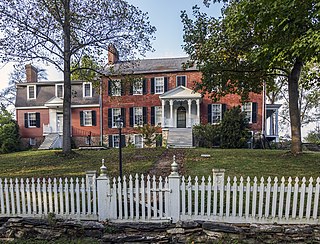
Hopewell is a set of historic homes and farm complexes located at Union Bridge, Carroll County, Maryland, United States. It consists of four related groupings of 19th century farm buildings. The Hopewell complex consists of two historic farms: Hopewell and the smaller F.R. Shriner Farm.
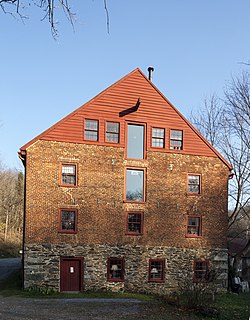
Lewis Mill Complex is a historic grist mill complex located at Jefferson, Frederick County, Maryland. The complex consists of seven standing structures, a house foundation, and the remains of an earlier millrace. It centers on an early 19th-century three-story brick mill structure with a gabled roof. The mill complex served German immigrant farmers in Middletown Valley between 1810 and the 1920s. It was rehabilitated in 1979-1980 for use as a pottery shop. Also in the complex are a stuccoed log house and log springhouse built about; a frame wagon shed and corn crib structure and frame barn dating from the late 19th century; and early 20th century cattle shelter and a frame garage.
Kefauver Place is a historic farm complex located at Rohrersville, Washington County, Maryland, United States. It includes a log cabin built about 1820; a log barn of about 1830 with later-19th-century additions; a 19th-century timber-framed corn crib; a two-story brick house constructed around 1880; an early-20th-century masonry root cellar; and a frame summer kitchen, hog pen, chicken house, and garage all dating from about 1930. Also on the property are two fieldstone spring enclosures. It is located on a 21-acre (85,000 m2) property.

Rufus Wilson Complex is a group of historic buildings located at Clear Spring, Washington County, Maryland, United States. The property includes a complex of mid-late 19th century buildings which create the center of a small rural settlement named Conococheague located on the National Road. The main house is a large brick dwelling with a mansard roof. This house incorporates a 2+1⁄2-story limestone dwelling built about 1850 by Rufus Wilson, which was enlarged to its present Second Empire style in the last quarter of the 19th century. Adjacent to the house is a brick post office and store, built about 1880 by Wilson, with an attached feed room of frame construction with weatherboard siding. A carriage house built about 1882 is located immediately behind the store and a bank barn and grazing area are located at the rear of these buildings. Also on the property is a small frame corn crib.
Nicodemus Mill Complex is a historic home and mill complex located at Keedysville, Washington County, Maryland, United States. It consists of a dated 1810 2+1⁄2-story, five-bay stone house with a mid-19th-century brick service wing, the ruins of a grist mill built about 1829, and an extensive complement of 19th-century domestic and agricultural outbuildings including a stone springhouse, stone-end bank barn, brick out kitchen, frame wash house, and a stuccoed stone secondary dwelling. It is an intact representative example of the type of farmstead characteristic of the region during the 19th century.

Philip and Uriah Arter Farm is a historic home and farm complex located at Union Mills, Carroll County, Maryland. The complex includes a frame house built about 1844, a frame bank barn built about 1888, and a deteriorated early-20th-century frame outbuilding. The house is a well-preserved example of a middling farmer's dwelling house from mid-19th-century Maryland.

The Bennett-Kelly Farm is an historic home and farm complex located at Sykesville, Carroll County, Maryland, United States. The complex consists of a stone and frame house, a stone mounting block, a stone smokehouse, a frame bank barn, a frame wagon shed, a frame chicken house, a concrete block dairy or tool shed, and a stone spring house. The original mid-19th century stone section of the house is three bays wide and two stories high. The house features a one-bay Greek Revival pedimented portico with Doric columns. It is an example of a type of family farmstead that characterized rural agricultural Carroll County from the mid 19th century through the early 20th century.

Rockland Farm is a historic home and farm complex located at Westminster, Carroll County, Maryland, United States. The complex consists of a brick house, the stone foundation of an 18th-century springhouse, as well as a large frame barn and a corn crib, both dating to the late 19th century. The house, built in 1795, retains the Pennsylvania German traditional three-room plan with a central chimney. It is a two-story, three-bay by two-bay brick structure on a stone foundation built into a slope.

Jeremiah Brown House and Mill Site is a Colonial-era mill complex and national historic district at Rising Sun, Cecil County, Maryland, United States. It consists of two distinct halves: a two-story, three-bay, gable-roofed stone structure built in 1757 by Jeremiah Brown, Sr., a Quaker from Pennsylvania; and a two-story, two-bay gable-roofed frame house built in 1904 by John Clayton on the site of the original 1702 log wing. Also on the property is a small 19th century bank barn; a reconstruction of the original mill built on top of the stone foundations of the 1734 Brown Water Corn and Gristmill; and the foundations of an 18th-century saw mill.
The Henry Smeltzer Farmstead is a historic home and farm complex located near Middletown, Frederick County, Maryland, United States. It includes a two-story six-bay brick farmhouse dating to about 1832, a frame bank barn ruin, and several rusticated concrete block silos. A concrete block slaughter house, weighing house well house and holding pens complete the complex, which was associated in the early and mid-twentieth century with Main's Meats in Middletown. The house is built into the hillside as a "bank house", with its cellar above grade on the south side. The front and rear elevations feature porches across their widths.


















